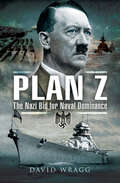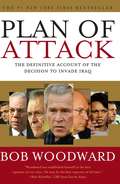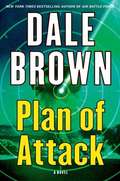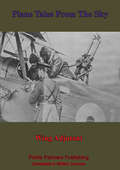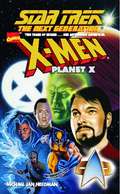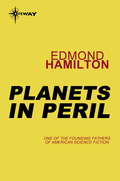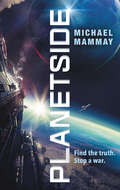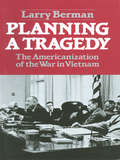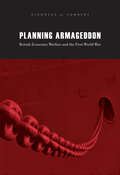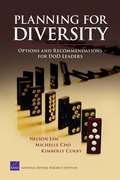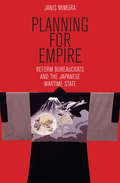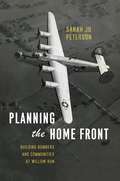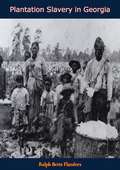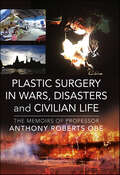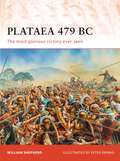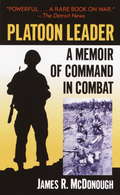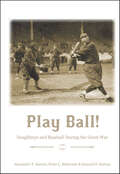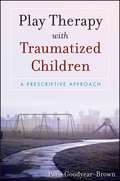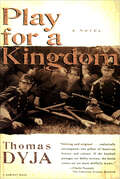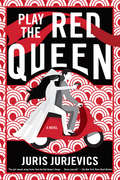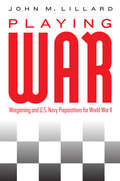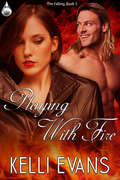- Table View
- List View
Plan Z: The Nazi Bid for Naval Dominance
by David Wragg&“A well-written yet concise history&” of Hitler&’s plan to build a massive naval fleet, why it failed, and how it may have affected the outcome of WWII (Nautical Research Journal). Except for the strength of the U-boat fleet at the height of the Battle of the Atlantic, the German Navy, or Kriegsmarine, was never a match for the Royal Navy, even though the latter was overstretched and fighting in the Atlantic, the Pacific, the Mediterranean, and the Arctic. It was not supposed to be that way. Hitler and his naval staff had a vision for a large and well-balanced fleet, including aircraft carriers. Plan Z was the name given for the massive fleet that Germany intended to build. However, the Plan relied on the outbreak of the war not occurring until at least 1942. This book examines the way in which such a fleet could have influenced the major battles between the Royal Navy and the Germans. Plan Z starts by looking at Germany&’s history and ambitions as a maritime power. The relationships among the three armed forces, and between them and the Fuhrer, are also examined, along with the country&’s economic and industrial position. Thanks to the author&’s detailed research, Plan Z considers whether the Nazis&’ ambitions could ever have been realized even if the war had been delayed due to the resource and manpower limitations—and also considers what the Royal Navy&’s response could have been. Includes photographs
Plan of Attack (Bush at War, Part II)
by Bob WoodwardPlan of Attack is the definitive account of how and why President George W. Bush, his war council, and allies launched a preemptive attack to topple Saddam Hussein and occupy Iraq. Bob Woodward's latest landmark account of Washington decision making provides an original, authoritative narrative of behind-the-scenes maneuvering over two years, examining the causes and consequences of the most controversial war since Vietnam. Based on interviews with 75 key participants and more than three and a half hours of exclusive interviews with President Bush, Plan of Attack is part presidential history charting the decisions made during 16 critical months; part military history revealing precise details and the evolution of the Top Secret war planning under the restricted codeword Polo Step; and part a harrowing spy story as the CIA dispatches a covert paramilitary team into northern Iraq six months before the start of the war. This team recruited 87 Iraqi spies designated with the cryptonym DB/ROCKSTARS, one of whom turned over the personnel files of all 6,000 men in Saddam Hussein's personal security organization. What emerges are astonishingly intimate portraits: President Bush in war cabinet meetings in the White House Situation Room and the Oval Office, and in private conversation; Dick Cheney, the focused and driven vice president; Colin Powell, the conflicted and cautious secretary of state; Donald Rumsfeld, the controlling war technocrat; George Tenet, the activist CIA director; Tommy Franks, the profane and demanding general; Condoleezza Rice, the ever-present referee and national security adviser; Karl Rove, the hands-on political strategist; other key members of the White House staff and congressional leadership; and foreign leaders ranging from British Prime Minister Blair to Russian President Putin. Plan of Attack provides new details on the intelligence assessments of Iraq's alleged weapons of mass destruction and the planning for the war's aftermath.
Plan of Attack (Patrick McLanahan Series #12)
by Dale BrownThe destruction of a Russian air base by robotic U.S. warplanes has reawakened the bear -- and America must pay a terrible price. In retaliation, Russia's leader launches the most devastating military sneak attack since Pearl Harbor, decimating America's strategic air forces. Now an embattled U.S. president must choose between two horrific scenarios: a cease-fire on the enemy's terms ... or respond with every weapon in the nation's arsenal, possibly triggering global thermonuclear war. Disgraced and demoted to a desk job, aerial warfare expert Brigadier General Patrick McLanahan saw the nightmare coming -- and only he can stop the relentless Russian war machine. But the fight for the future must take place in the blazing skies, a battlefield off-limits to the discredited former commander of Air Battle Force ... unless McLanahan takes matters into his own hands.
Plane Spotter's Guide
by Tony HolmesAviation has revolutionised warfare over the last 100 years, and this new pocket guide gives the reader the essential details of 70 iconic aircraft, including the Sopwith Camel, the Spitfire, the Messerschmitt Bf 109, the P-51 Mustang and the F-4 Phantom. Drawing on Osprey's comprehensive aviation archive, the Plane Spotter's Guide uses detailed profile artwork to illustrate and aid recognition, as well as specification boxes to provide all the technical details.
Plane Tales From The Sky
by Wing Adjutant"Air Combat over the trenches by those who foughtThe first-hand accounts of the experiences of men in time of war always make fascinating reading. Their stories are, of course, always as varied as the individuals concerned and the eras to which they belonged, whether they were soldiers, sailors or airmen, the branch of their service, their nationalities, the conflict in which they were participants and in which theatre they fought. This is what makes military history so fascinating. Sometimes many men report a common experience that abided for decades. Occasionally we hear, across time, the voices of a few notable men who fought their own war in their own special way and once their time had past history would never know their like again. That is especially true of the pilots of the First World war. The machinery of flight was a new technology. The aircraft were raw, basic, flimsy and unproven machines and both they and the brave men who piloted them were fighting their first conflict while learning and evolving their skills and equipment, quite literally, as they fought and died. The dogfight days of the early biplanes, triplanes and early mono winged fighters would be short, but their images together with those of the iconic airships which they ultimately destroyed will remain indelibly imprinted on the history of conflict and the development of man's mastery of the air. Heroes to a man, these trailblazers were almost always young, carefree, well-educated and modest young men full of the joy of living and commitment to their aircraft and to flying."-Leonaur Print VersionAuthor -- Wing Adjutant (Pseud.)Text taken, whole and complete, from the edition published in London, New York, Cassell and company, ltd., 1918.Original Page Count - 182 pages
Planet X (Star Trek: The Next Generation)
by Michael Jan FriedmanAn exciting crossover between the Starfleet's finest crew and Earth's greatest mutant heroes who must team together to stop a deadly threat to the Federation. On the planet Xhaldia, ordinary men and women are mutating into bizarre creatures with extraordinary powers. But is this a momentous evolutionary leap or an unparalleled catastrophe? The very fabric of Xhaldian society is threatened as fear and prejudice divide the transformed from their own kin. Dispatched to cope with the growing crisis, Captain Picard and the crew of the Starship Enterprise™ receive some unexpected visitors from another reality -- in the form of the group of mutant heroes known as the uncanny X-Men®. Storm, leader of the X-Men, offers their help in resolving a situation that is agonizingly similar to the human/mutant conflicts of their own time and space. But when hostile aliens appear in orbit around Xhaldia to try and abduct the transformed for use as a superpowered force in an attack on the Federation, even the combined forces of the crew of Starfleet and the X-Men may be unable to prevent an inferno of death and destruction. Starfleet's finest crew and Earth's greatest mutant heroes will need all their powers and abilities to save the Xhaldian people and stop a deadly threat to the Federation.
Planets in Peril
by Edmond HamiltonThey were the first arrivals from the other side of the cosmos.With the help of the Martian scientist Thrin, they had crossed the whirling black abyss of the fourth dimension - a dimension that had never been reached before!Now a man with skin of pure marble-white and a woman of unearthly beauty stood before the disbelieving eyes of Captain Future and the Futuremen. The strange couple stared back in awe and amazement - particularly at Captain Future."Here is the one," the man said finally in his alien tongue. "He is the only one who can save us!"
Planetside
by Michael Mammay--“PLANETSIDE is a smart and fast-paced blend of mystery and boots-in-the-dirt military SF that reads like a high-speed collision between Courage Under Fire and Heart of Darkness.” – Marko Kloos, bestselling author of the Frontline series--“Not just for military SF fans—although military SF fans will love it—Planetside is an amazing debut novel, and I’m looking forward to what Mammay writes next.” – Tanya Huff, author of the Confederation and Peacekeeper series--“A tough, authentic-feeling story that starts out fast and accelerates from there.” – Jack Campbell, author of Ascendant --“Definitely the best military sci-fi debut I’ve come across in a while.” – Gavin Smith, author of Bastard Legion and Age of ScorpioA seasoned military officer uncovers a deadly conspiracy on a distant, war-torn planet…War heroes aren't usually called out of semi-retirement and sent to the far reaches of the galaxy for a routine investigation. So when Colonel Carl Butler answers the call from an old and powerful friend, he knows it's something big—and he's not being told the whole story. A high councilor's son has gone MIA out of Cappa Base, the space station orbiting a battle-ravaged planet. The young lieutenant had been wounded and evacuated—but there's no record of him having ever arrived at hospital command.The colonel quickly finds Cappa Base to be a labyrinth of dead ends and sabotage: the hospital commander stonewalls him, the Special Ops leader won't come off the planet, witnesses go missing, radar data disappears, and that’s before he encounters the alien enemy. Butler has no choice but to drop down onto a hostile planet—because someone is using the war zone as a cover. The answers are there—Butler just has to make it back alive…
Planning A Tragedy: The Americanization of the War in Vietnam
by Larry Berman"Takes an historically important decision, places it in its immediate stream of policy development, perceptions and events and adds what was missing from the Pentagon Papers."--Richard E. Neustadt, Harvard University "A thoroughly researched and highly perceptive study of the decisions that turned the tribal struggle in Vietnam into an American war. Berman's book fully documents the role of domestic policy in our tragic involvement. As one who watched the process at firsthand. I commend Professor Berman's book for its fairness and insight."-- George W. Ball
Planning Armageddon: British Economic Warfare and the First World War
by Nicholas A. LambertBefore the First World War, the British Admiralty conceived a plan to win rapid victory in the event of war with Germany-economic warfare on an unprecedented scale.This secret strategy called for the state to exploit Britain's effective monopolies in banking, communications, and shipping-the essential infrastructure underpinning global trade-to create a controlled implosion of the world economic system. In this revisionist account, Nicholas Lambert shows in lively detail how naval planners persuaded the British political leadership that systematic disruption of the global economy could bring about German military paralysis. After the outbreak of hostilities, the government shied away from full implementation upon realizing the extent of likely collateral damage-political, social, economic, and diplomatic-to both Britain and neutral countries. Woodrow Wilson in particular bristled at British restrictions on trade. A new, less disruptive approach to economic coercion was hastily improvised. The result was the blockade, ostensibly intended to starve Germany. It proved largely ineffective because of the massive political influence of economic interests on national ambitions and the continued interdependencies of all countries upon the smooth functioning of the global trading system. Lambert's interpretation entirely overturns the conventional understanding of British strategy in the early part of the First World War and underscores the importance in any analysis of strategic policy of understanding Clausewitz's "political conditions of war."
Planning for Diversity: Options and Recommendations for DoD Leaders
by Nelson Lim Kimberly Curry Hall Michelle ChoDiscusses initial steps that the Department of Defense (DoD) should take in developing a department-wide strategic plan to achieve greater diversity within its active duty and civilian leadership. Key questions include how diversity will be defined, how progress toward diversity will be measured, and how DoD leaders will hold themselves and others accountable for such progress. Includes a summary of findings from the 2007 DoD Diversity Summit.
Planning for Empire: Reform Bureaucrats and the Japanese Wartime State (Studies of the Weatherhead East Asian Institute, Columbia University)
by Janis MimuraJapan’s invasion of Manchuria in September of 1931 initiated a new phase of brutal occupation and warfare in Asia and the Pacific. It forwarded the project of remaking the Japanese state along technocratic and fascistic lines and creating a self-sufficient Asian bloc centered on Japan and its puppet state of Manchukuo. In Planning for Empire, Janis Mimura traces the origins and evolution of this new order and the ideas and policies of its chief architects, the reform bureaucrats. The reform bureaucrats pursued a radical, authoritarian vision of modern Japan in which public and private spheres were fused, ownership and control of capital were separated, and society was ruled by technocrats.Mimura shifts our attention away from reactionary young officers to state planners—reform bureaucrats, total war officers, new zaibatsu leaders, economists, political scientists, engineers, and labor party leaders. She shows how empire building and war mobilization raised the stature and influence of these middle-class professionals by calling forth new government planning agencies, research bureaus, and think tanks to draft Five Year industrial plans, rationalize industry, mobilize the masses, streamline the bureaucracy, and manage big business. Deftly examining the political battles and compromises of Japanese technocrats in their bid for political power and Asian hegemony, Planning for Empire offers a new perspective on Japanese fascism by revealing its modern roots in the close interaction of technology and right-wing ideology.
Planning the Home Front: Building Bombers and Communities at Willow Run
by Sarah Jo PetersonBefore Franklin Roosevelt declared December 7 to be a OC date which will live in infamyOCO; before American soldiers landed on D-Day; before the B-17s, B-24s, and B-29s roared over Europe and Asia, there was Willow Run. Located twenty-five miles west of Detroit, the bomber plant at Willow Run and the community that grew up around it attracted tens of thousands of workers from across the United States during World War II. Together, they helped build the nationOCOs OC Arsenal of Democracy, OCO but Willow Run also became the site of repeated political conflicts over how to build suburbia while mobilizing for total war. In "Planning the Home Front," Sarah Jo Peterson offers readers a portrait of the American peopleOCoindustrialists and labor leaders, federal officials and municipal leaders, social reformers, industrial workers, and their familiesOCothat lays bare the foundations of community, the high costs of racism, and the tangled process of negotiation between New Deal visionaries and wartime planners. By tying the history of suburbanization to that of the home front, Peterson uncovers how the United States planned and built industrial regions in the pursuit of war, setting the stage for the suburban explosion that would change the American landscape when the war was won.
Plantation Slavery in Georgia
by Ralph Betts FlandersAn examination of the foundation of slavery in Georgia, to trace the development and operation of the plantation régime to the outbreak of the Civil War. The book was awarded the Mrs. Simon Baruch University prize of 1931, given under the auspices of the United Daughters of the Confederacy.“Mr. Flanders sets a good example for future historians in other commonwealths by his book on Georgia.”—C. McD. Puckette, The New York Times Book Review
Plantations, Proletarians and Peasants in Colonial Asia
by Tom Brass E. Valentine Daniel Henry BernsteinThis volume originated in a conference on 'Capitalist Plantations in Colonial Asia', held at the Centre for Asian Studies of the University of Amsterdam and Free University of Amsterdam in September 1990. The contributions to this collection focus on the production of rubber, sugar, tea, and several less strategic plantation crops, in colonial Indochina, Java, Malaya, the Philippines, India, Ceylon, Mauritius and Fiji (although geographically anomalous, both the latter are included because of the centrality to their sugar plantations of indentured labour from India).
Plastic Surgery in Wars, Disasters and Civilian Life: The Memoirs of Professor Anthony Roberts OBE
by Anthony RobertsThe specialty of plastic surgery was developed and named by Sir Harold Gillies following his work between the two world wars reconstructing severely damaged servicemen from the First World War. Sir Harold went on to inspire and train other surgeons from around the world. Among them was his cousin Sir Archibald McIndoe, who in the Second World War set up the unit at East Grinstead Hospital which looked after severely burned airmen and some other servicemen. The airmen themselves set up the famous Guinea Pig Club which gave enormous social and often financial support to the severely injured. After the Second World War specialized burn units were created throughout the UK, including one at Stoke Mandeville Hospital, where Anthony Roberts served. After the number of war injuries had reduced, the burn unit for all three services was set up at RAF Halton, a few miles from Stoke Mandeville. A close relationship between the hospitals developed which led to military surgeons being posted to Stoke Mandeville for training in the care of burns and an introduction to plastic surgery. Most doctors will never be involved in a disaster during their working lives. Anthony Roberts was involved in treating casualties from the Bradford City football stadium fire in 1985 that claimed 56 lives and resulted in hundreds more being injured, many of them with severe burns. It had a major effect on him, and on all those involved. It started his appearances on the media and his overseas visits to other countries to talk about it. And subsequently he was asked to join and to lead other international efforts to provide help. He led the first British team from Stoke Mandeville that gave aid in Sarajevo during the war. He returned several times and has also given aid in three other war zones and six major disasters. Because of this involvement in all these situations Professor Roberts taught junior trainee surgeons from the three British services and those of several foreign countries. As well as his military involvement, Anthony Roberts spent sixteen years working with the Royal Protection Group at State occasions, and thirty years working as a motor racing track doctor including at Formula One level, providing immediate and vital treatment to drivers who suffered serious injuries and burns following accidents on the track and to spectators. There have been enormous changes in the specialty over the past fifty years and a detailed view of these is given in an absorbing account of this life-enhancing surgery by one who served on the frontline in difficult and dangerous situations around the world.
Plataea 479 BC
by Peter Dennis William ShepherdPlataea was one of the biggest and most important land battles of pre-20th century history. Close to 100,000 hoplite and light-armed Greeks took on an even larger barbarian army that included elite Asian cavalry and infantry from as far away as India, with thousands of Greek hoplites and cavalry also fighting on the Persian side. At points in the several days of battle, the Persians with their more fluid, missile tactics came close to breaking the Greek defensive line and cutting off their supplies. But, in a fatal misjudgement when he nearly had the battle won, their general Mardonius committed the cream of his infantry to close-quarters combat with the Spartans and their Peloponnesian allies. He died and his men were finally crushed by heavier weaponry and superior discipline. Meanwhile, 250 miles to the east, the Greek navy inflicted an equally decisive defeat on the Persians, neutralising Xerxes' seapower in the Aegean. The tiny minority of Greek city states that actually took up arms against the invading forces of the mightiest empire yet seen in the ancient world had halted its western expansion and driven it back.The reconstruction of the battle of Plataea will draw on recent persuasive academic interpretations of the textual sources and visual evidence (mainly from near-contemporary vase paintings) for the early 5th-century method of hoplite fighting.From the Trade Paperback edition.
Platoon Leader
by James R. McdonoughA remarkable memoir of small-unit leadership and the coming of age of a young soldier in combat in Vietnam.'"Using a lean style and a sense of pacing drawn from the tautest of novels, McDonough has produced a gripping account of his first command, a U.S. platoon taking part in the 'strategic hamlet' program. . . . Rather than present a potpourri of combat yarns. . . McDonough has focused a seasoned storyteller's eye on the details, people, and incidents that best communicate a visceral feel of command under fire. . . . For the author's honesty and literary craftsmanship, Platoon Leader seems destined to be read for a long time by second lieutenants trying to prepare for the future, veterans trying to remember the past, and civilians trying to understand what the profession of arms is all about."-Army TimesFrom the Paperback edition.
Platoon Leader: A Memoir of Command in Combat
by James R. McdonoughA remarkable memoir of small-unit leadership and the coming of age of a young soldier in combat in Vietnam. ' "Using a lean style and a sense of pacing drawn from the tautest of novels, McDonough has produced a gripping account of his first command, a U. S. platoon taking part in the 'strategic hamlet' program. . . . Rather than present a potpourri of combat yarns. . . McDonough has focused a seasoned storyteller's eye on the details, people, and incidents that best communicate a visceral feel of command under fire. . . . For the author's honesty and literary craftsmanship,Platoon Leaderseems destined to be read for a long time by second lieutenants trying to prepare for the future, veterans trying to remember the past, and civilians trying to understand what the profession of arms is all about. "-Army Times From the Paperback edition.
Play Ball!: Doughboys and Baseball during the Great War
by Alexander F. Barnes Peter L. Belmonte Samuel O. BarnesMany major- and minor-league ballplayers traded their team uniforms for Army khaki and Navy blue
Play Therapy With Traumatized Children: A Prescriptive Approach
by Paris Goodyear-BrownIntroducing a practical model of play therapy for traumatized children Some of the most rewarding work a therapist can do is help a child recover from a traumatic event. But where to begin? A growing body of play therapy literature offers many specific techniques and a variety of theoretical models; however, many therapists are still searching for a comprehensive model of treatment that incorporates solid theoretical constructs with effective play therapy interventions. Clinicians have long recognized that trauma therapy is not just a matter of techniques but a journey with a beginning, middle, and end. In a pioneering contribution to the field, Play Therapy with Traumatized Children: A Prescriptive Approach, the author codifies the process in her model, Flexibly Sequential Play Therapy (FSPT). Integrating non-directive and directive approaches, this components-based model allows for the uniqueness of each child to be valued while providing a safe, systematic journey towards trauma resolution. The FSPT model demystifies play-based trauma treatment by outlining the scope and sequence of posttraumatic play therapy and providing detailed guidance for clinicians at each step of the process. Dramatically demonstrating the process of healing in case histories drawn from fifteen years of clinical practice with traumatized children, Play Therapy with Traumatized Children addresses: -Creating a safe place for trauma processing -Augmenting the child's adaptive coping strategies and soothing his or her physiology -Correcting the child's cognitive distortions -Ensuring that caregivers are facilitative partners in treatment Inviting gradual exposure to trauma content through play -Creating developmentally sensitive trauma narratives -Using termination to make positive meaning of the post-trauma self.
Play for A Kingdom: A Novel
by Thomas DyjaIn this “brilliantly imagined and neatly plotted” Civil War novel (Boston Globe), two battle-scarred companies-one Union, one Confederate-embark on a series of baseball games amid the carnage at Spotsylvania. “Wonderfully conceived and eloquently executed” (Caleb Carr). Maps.
Play the Red Queen: A Novel
by Juris JurjevicsThe posthumous masterwork by critically acclaimed author, storied publisher, and Viet Nam veteran Juris Jurjevics—the story of two American GI cops caught in the corrupt cauldron of a Vietnamese civil war stoked red hot by revolution. Viet Nam, 1963. A female Viet Cong assassin is trawling the boulevards of Saigon, catching US Army officers off-guard with a single pistol shot, then riding off on the back of a scooter. Although the US military is not officially in combat, sixteen thousand American servicemen are stationed in Viet Nam “advising” the military and government. Among them are Ellsworth Miser and Clovis Robeson, two army investigators who have been tasked with tracking down the daring killer.Set in the besieged capital of a new nation on the eve of the coup that would bring down the Diem regime and launch the Americans into the Viet Nam War, Play the Red Queen is Juris Jurjevics’s capstone contribution to a lifelong literary legacy: a tour-de-force mystery-cum-social history, breathtakingly atmospheric and heartbreakingly alive with the laws and lawlessness of war.
Playing War: Wargaming and U.S. Navy Preparations for World War II
by John M. LillardBetween the First and Second World Wars, the U.S. Navy used the experience it had gained in battle to prepare for future wars through simulated conflicts, or war games, at the Naval War College. In Playing War John M. Lillard analyzes individual war games in detail, showing how players tested new tactics and doctrines, experimented with advanced technology, and transformed their approaches through these war games, learning lessons that would prepare them to make critical decisions in the years to come. Recent histories of the interwar period explore how the U.S. Navy digested the impact of World War I and prepared itself for World War II. However, most of these works overlook or dismiss the transformational quality of the War College war games and the central role they played in preparing the navy for war. To address that gap, Playing War details how the interwar navy projected itself into the future through simulated conflicts. Playing War recasts the reputation of the interwar War College as an agent of preparation and innovation and the war games as the instruments of that agency.
Playing With Fire
by Kelli EvansTightly wound Ryleigh Lawson has it all. The job, the fancy Chicago high-rise apartment overlooking Lake Michigan, and a promising future. Jude Thomas, the sexy backwoodsman, lives in a loft above his bar in Michigan's Upper Peninsula. He doesn't have much and doesn't need much. The paths of these two people from very different worlds should never have crossed. With help from a particularly nasty snowstorm, a lemon-yellow AMC Gremlin, and a dog with mismatched eyes, their worlds collide. Snowed in, they are forced to shack up together for a long week. Though they grate on each other, they still spark like flint on steel. A friendship blossoms, and chemistry and passion rage, but when the snow begins to thaw and they are thrust out of their winter wonderland cocoon and back to their previous lives, are they capable of returning to who they were before the snowstorm? After playing with fire, can they come away anything other than burned?
